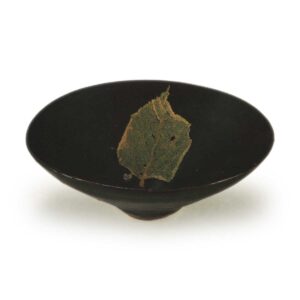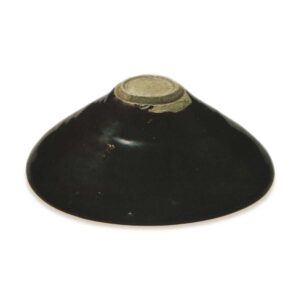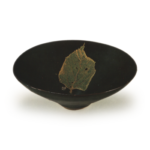

Important Cultural Property
Height: 5.1-5.3cm
Diameter: 14.7-14.9cm
Outer diameter of foot ring: 3.3cm
Height of foot ring: 0.4cm
Making full use of their subtle glaze techniques, the potters of the Kichijū kiln added a new twist to the paper-cut patterns, and also succeeded in a new technique of inlaying real leaves onto the surface of the bowl. The idea was probably obtained during the application of the paper stencil, but whereas the stencil pattern was cut out in black in the seaweed-like ash glaze, this method is to cut out the leaf stencil in black on a black background, so that the leaf pattern stands out in yellow. This attractive technique is being tried out in various ways in Japan these days. The usual theory is that it is possible to make this by simply sticking the leaves on top of the black glaze and firing it. However, since the leaves turn to ash in the kiln, they naturally become glazed, and even if the shape of the leaves appears as it is, you cannot expect a vivid effect from this alone. The key is the combination of the leaves and the yellow glaze, and the composition of the yellow glaze. However, today, none of these methods have been able to achieve the same level of realism as the Yixiu ware in terms of the leaf patterns. Scholars in the new China have suggested that the leaves were first painted with yellow glaze on the base, then the corroded leaves with only the veins were attached, black glaze was applied, the leaves were removed, the mold was left, and the piece was fired.
Now, the Mokuha Tenmoku in this picture is a famous bowl that has been passed down through the Maeda family of Kaga, and is considered to be a superbly crafted piece that stands out among similar works for its delicate, elegant, and lifelike effect. The clay is the usual pale yellowish-white, and the bowl has been carelessly shaped on a well-practiced potter’s wheel. As usual, the foot ring has been shaved down to a small size, and only that part is visible. The rim is sharp and the cut marks are clearly visible. This is a thin, well-proportioned flat bowl. The black glaze is a deep blackish brown glaze with a dark purple tinge, known in China as “plaster black” or “soy sauce color”. It is a deep black with a moist sheen and a moderate gloss. In this black glaze, a single leaf has been attached to the perfect position, both in terms of shape and size. It is a shame that it is a dead leaf, but the delicate veins that are half-transparent show a complex pattern of blue, green, yellow and white on a black background, it is exquisite, and within the subtle changes in shade and color, the tiny traces of insect damage can be seen through the black, and the crumpled shape of the leaf edges, these delicate natural designs are truly mysterious. There is probably no other ceramic technique that has captured the wonders of nature so vividly.
Accessories: The thin, elegant gold rim that used to be attached has now been removed and is stored together with the tea bowl. However, the box inscription reads “Shinchu Fukurin Hei Tea Bowl”.
History: The Kaga Maeda family inherited many famous Tenmoku tea bowls, but this is the most fascinating of them all. Currently in the collection of a certain family in Kyoto.








